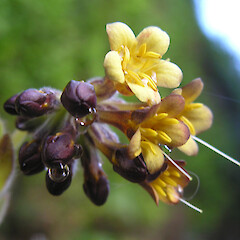Myosotis macrantha
Common name
bronze forget-me-not
Synonyms
Exarrhena macrantha Hook.f., Myosotis macrantha var. diversa G.Simpson et J.S.Thomson, Myosotis macrantha var. pulchra Cheeseman, Myosotis macrantha var. westlandica Petrie
Family
Boraginaceae
Flora category
Vascular – Native
Endemic taxon
Yes
Endemic genus
No
Endemic family
No
Structural class
Herbs - Dicotyledons other than Composites
NVS code
The National Vegetation Survey (NVS) Databank is a physical archive and electronic databank containing records of over 94,000 vegetation survey plots - including data from over 19,000 permanent plots. NVS maintains a standard set of species code abbreviations that correspond to standard scientific plant names from the Ngä Tipu o Aotearoa - New Zealand Plants database.
MYOMAC
Chromosome number
2n = 48
Current conservation status
The conservation status of all known New Zealand vascular plant taxa at the rank of species and below were reassessed in 2017 using the New Zealand Threat Classification System (NZTCS) – more information about this can be found on the NZTCS website. This report includes a statistical summary and brief notes on changes since 2012 and replaces all previous NZTCS lists for vascular plants.
Please note, threat classifications are often suggested by authors when publications fall between NZTCS assessment periods – an interim threat classification status has not been assessed by the NZTCS panel.
- Conservation status of New Zealand indigenous vascular plants, 2017 . 2018. Peter J. de Lange, Jeremy R. Rolfe, John W. Barkla, Shannel P. Courtney, Paul D. Champion, Leon R. Perrie, Sarah M. Beadel, Kerry A. Ford, Ilse Breitwieser, Ines Schönberger, Rowan Hindmarsh-Walls, Peter B. Heenan and Kate Ladley. Department of Conservation. Source: NZTCS and licensed by DOC for reuse under the Creative Commons Attribution 4.0 International licence.
2017 | Not Threatened
Previous conservation statuses
2012 | Not Threatened
2009 | Not Threatened
2004 | Not Threatened
Distribution
Endemic: South Island: Nelson to south-western Otago and northern Southland
Habitat
Alpine. Common in damp sites within grassland, on rocky ground, on cliff faces and rock outcrops
Detailed description
Robust, tufted, grey-green, green to dark green, perennial herb. Rosettes few or many, leaves obovate, obovate-lanceolate to lanceolate-spathulate, 30-120 × 6-20 mm, narrowing rather abruptly to subacute tip and gradually to broad petiole almost as long as lamina; hairs tapering and flexuous, appressed or spreading, on undersurface shorter, sparser, often appressed, retrorse except sts at tip. Lateral branches few per rosette, ascending to erect, up to 300 mm long, internodes usually < leaves. Stem-leaves decreasing upwards, lower ones oblong, uppermost c.20 × 6 mm, lanceolate with truncate base and subacute tip; hairs long, fine, usually crowded and appressed on upper surface, on undersurface sparser, shorter and more spreading, often retrorse towards base of lower stem-leaves. Cymes ebracteate, usually simple or once branched, 8-flowered, up to 70 mm long in fruit, internodes < calyx in fruit; pedicels very short, Calyx 6-9 mm long, lobes usually slightly > 1/2 length, obtuse, rather broad; hairs long and spreading near top, medium and hooked about middle, short and spreading or retrorse near base, short appressed hairs throughout. Corolla yellow, orange, brownish orange to almost black, narrow-funnelform, 6-8 mm diameter, tube up to 10 mm. (occasionally 15 mm) to level of scales, more to sinus of lobes; scales small or absent, sometimes variously developed in one flower, lobes rounded, c.3.0 × 2.5 mm, not widely spreading; filaments broad, fixed just below scales (if any), about equal to anthers which are 1·5-2·2 mm long and wholly above scale-level; style at least 2× calyx in fruit, stigma capitate. Nutlet 2.4-3.5 × 1.4-2.0 mm long, ovate-elliptic to elliptic, black-brown to black.
Similar taxa
Myosotis macrantha is a rather variable but extremely distinctive species easily recognised by its robust growth habit and colourful flowers which can be fixed or grade on a plant from yellow through orange to orange-brown or almost black. It is closely allied to Myosotis arnoldii from which it differs by the grey-green, green to dark green (rather than silvery) colour of the vegetative parts, by the rosette leaves which are broader than the stem leaves (in M. arnoldii rosette and stem leaves are of equal width), and by the presence of retrorse rather than straight hairs on the leaves. The flowers of Myosotis macrantha differ from M. arnoldii only in that their lobes seem to spread more widely (and they show a greater range of colours). Vegetatively Myosotis macrantha is impossible to distinguish from the narrow-range endemic M. explanata though the long narrow strongly coloured flowers of M. macrantha with the anthers exserted wholly beyond the ill-developed scales differ greatly from the shorter, salverform, pure white flowers of M. explanata whose anthers are scarcely exserted and whose filaments are positioned below the large scales.
Flowering
December - March
Flower colours
Orange, Yellow
Fruiting
Febuary - May
Propagation technique
Somewhat difficult. Can be grown in a rock garden or alpine house but results vary. Like all indigenous Myosotis this species is sensitive to humidity and prone to fungal attacks from mildews and rusts in muggy weather. In some parts of New Zealand, such as the South Island this species can be easily cultivated.
Etymology
myosotis: Mouse-eared
macrantha: Big flowered
Where To Buy
Not commercially available
Attribution
Fact Sheet prepared for NZPCN by P.J. de Lange 1 February 2008; Description based on Allan (1961)
References and further reading
Allan, H.H. 1961: Flora of New Zealand. Vol. I. Goverment Printer, Wellington.
NZPCN Fact Sheet citation
Please cite as: de Lange, P.J. (Year at time of access): Myosotis macrantha Fact Sheet (content continuously updated). New Zealand Plant Conservation Network. https://www.nzpcn.org.nz/flora/species/myosotis-macrantha/ (Date website was queried)















